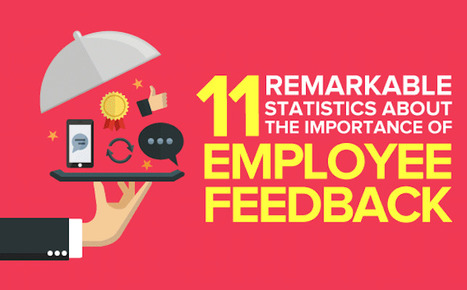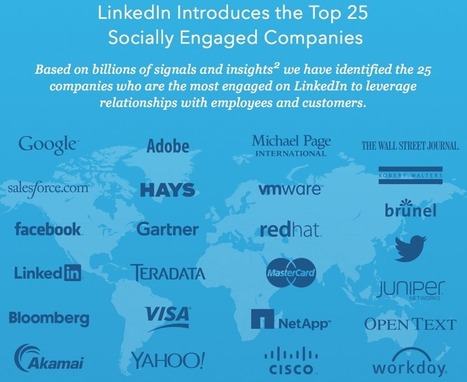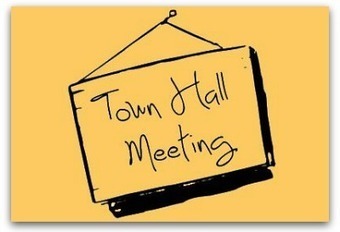 Your new post is loading...
 Your new post is loading...
There’s a great quote from Confucius: “Tell me, and I will forget. Show me, and I may remember. Involve me, and I will understand." People will more readily help bring to life the changes that they are involved with. How are you involving your people in the changes that need to be implemented?...
Leaders of reorgs typically fall into one of two traps when communicating with their employees. We’ll call the first one wait and see and the second ivory-tower idealism. Perhaps you have seen one, or both, in your own reorgs.
In the first trap, wait and see, the leader of the reorg thinks everything should be kept secret until the last moment, when he or she has all the answers. The leader makes the reorg team and leadership swear to secrecy and then is surprised when the news leaks to the wider organization (it always does, we’re afraid). As the reorg team starts to engage with the rest of the organization, the rumors round the water cooler increase: “They were asking what my team does”; “I had to fill in an activity analysis form”; “I hear that 20 percent of jobs are going to go.” Everyone thinks the real reason for the reorg is job losses (whether it is or not). The leader, desperate to get in control of the situation, pushes the team to develop “the answer” so that he or she can tell the organization. Without an “answer,” the leader feels that any communication would come across as defensive. At most, the executive approves some question-and-answer sessions on the reorg. But a full-scale communication needs to wait. Eventually, the leader has the answer: the reorg team produces a high-level org chart. The leader then announces the new organization: here are the new leaders, here is the structure, some job losses are necessary, but this is going to help us deliver fantastic results. Employees, hearing this, hear only that their boss’s boss’s boss is going to change and that some of them are going to lose their jobs. Nothing their leader has said counters the impressions they formed at the water cooler.
Ivory-tower idealism fares little better. In this version, the leader of the reorg is finally getting a long-achieved objective: all the issues of the old organization will finally get fixed; everything the leader wanted to do, but was held back from, can now be achieved. The leader can barely contain the excitement. So psyched up by the possibilities that the reorganization offers, the leader decides to start the process with a webcast to all staff, telling them about the exciting business opportunities it will open up. The leader follows this up with a series of walk-arounds in the major plants and offices, discussing the opportunities and getting input on some of the challenges that people face in the organization today. The leader puts a personal blog on the company intranet....
Early last year, our company, Duarte Inc., was well into a great season of change. We had turned our org chart on its side, so that nearly every person in the company either had a new boss or was a new boss. We had moved to a different building. We had implemented new software tools. We were about to release a new book. And we did all this while trying to perform our jobs at the highest possible level. People were tired and stressed. We knew deep down how much we really enjoyed and respected one another, but the pain of change made it difficult to for us to connect with that feeling. We had to do something special to rekindle it. So we set aside some time over the course of a week for employees to meet in small groups and talk about how we could best move forward, strong and united. Then, that Friday afternoon, everyone gathered in a large, open area in the office. The seats were arranged in a semi-circle, and a large drum stood in front of each seat. Over the next two hours, all of us (100-plus employees) beat our drums — first chaotically like a first-grade music class, and then, with the help of a music coach, in unison....
Work customs and culture vary from country to country. For instance, meeting attendees in the U.S. seat themselves in no particular order around the conference table. But if the most junior person on the team were to take the seat farthest from the door in Japan? That's a no-no. This behavior flies in the face of Japanese custom, where the seating arrangement is determined by professional seniority (the most senior people sit farthest from the door, and the most junior people closest). But while there are no doubt differences in work styles around the world, there are also similarities. After surveying nearly 200 leaders located in 15 different countries, Quantum Leadership Group recently discovered the most important leadership trait worldwide: High ethical and moral standards.In a Harvard Business Review article covering the data, Sunnie Giles, president of Quantum Leadership Group, categorized this response along with the third most important trait ("clearly communicates expectations") as qualities that "creat[e] a safe and trusted environment."...
Days after taking over as Twitter’s permanent CEO, Jack Dorsey has laid off 336 people. You could learn a lot from the straightforward, honest, and sensitive way he tells his company about it.
The corporate layoff is a communications trap for leaders. It makes them insecure, so they they adopt HR bullshit and talk about “reduction in force”, “rightsizing”, “eliminating positions.” But they don’t have to. Here’s how Jack Dorsey told Twitter he was letting a big chunk of the company go....
It's every manager's responsibility to provide meaningful feedback on a regular basis. And that doesn't mean waiting for the annual review to roll around: Employees that are highly engaged at work receive employee feedback at least once a week.
But giving feedback regularly isn't just beneficial for the employee -- it's beneficial for the team, too. Did you know that receiving feedback can actually inspire your employees to work harder and become more engaged? In fact, 69% of employees say they would work harder if they felt their efforts were being better recognized. Employees who receive little or no feedback from their managers tend to disengage from their work more readily....
LinkedIn and Altimeter Group published a joint report on the value of corporate social media and its role in customer and employee engagement. To do, we formed a baseline of companies that were actively engaged on a platform we could effectively study.
After eight months of research, we assembled a list of the Top 25 Socially Engaged Companies based on how they use LinkedIn to engage employees and customers in the following areas: 1. Content marketing 2. Employee engagement 3. Talent and recruitment 4. SalesLinkedIn and Altimeter Group then conducted targeted and controlled surveys to gather insights into how employees feel about their company’s use of social media.
The results of both studies were visualized in one infographic entitled, “Relationship Economics.” ....
So often we can feel like we are drowning in a sea of monotony. Find a cause that makes you want to wake up every morning and change the world.
... Having a role is good. Doing well feels great. Being acknowledged for a job well done feels even better. That sensation we get when we do something right and you know that everyone around is thinking, “dang, you go!” instills a sense of pride that no one can take away.
That feeling can be hard to come by. So often we can feel like we are drowning in a sea of monotony. So many of us start work thinking that this is going to be the right place to work and you work there and it turns out your boss is a jerk or your coworkers suck or it’s just not what you wanted. Quitting usually seems like the best option at that point. That is okay!..
CEOs often are in the dark as to whether their people truly understand their vision. It's a dangerous place to be, and it's a difficult situation to diagnose and address....
When you step on stage at the company meeting, are those smiling, nodding heads really absorbing the new company vision and goals for the year? According to a recent Harvard Business Review article, “When CEOs Talk Strategy, Is Anyone Listening?” only a fraction of our workforce is really clued in.
The article cites recent research which says that even in high-performing companies with “clearly articulated public strategies,” only 29% of their employees can correctly identify their company’s strategy out of six choices.This is not the strategy du jour. This is your company’s core, single most important strategic statement – a definition of why the business exists and why it’s worth investing in for the future. That means 70% (7 out of 10) of all employees (yes, even yours) are unknowingly misaligned with your company’s strategic direction....
I have evaluated dozens of CEO/executive town halls. As idealists, when we plan these events we envision a turn-of-the-century town hall during which passionate employees engage in vigorous debate with organizational leaders.... Most forums have too much content and a lengthy presentation with too much detail. In addition to substance, our leaders tend to be too positive and rarely negative, and employees don't think they are getting the truth. This sort of comment is heard: "That is not the real strategy; the real strategy happens behind closed doors." The good news is that employees tell me they really do want to know and understand strategy and what is impacting the business. They just don't believe that happens in leader forums. Senior executives tell me they want to know the best way to share their direction and strategy for the organization. Employees tell me they want the truth. They want unscripted answers and to participate in a discussion about the competing demands placed on the business....
Prescient Digital Media's 2013 study found the implementation of social intranet tools on the rise at most businesses, but satisfaction is quite low. Why aren't employees and executives happier? The firm's 2013 Social Intranet Study found that 76 percent of the companies surveyed use instant messaging, at least in some limited way. About 75 percent use blogs. Around two-thirds have wikis, discussion forums, and user comments. It's fair to say social tools are being used widely. However, only 19 percent of organizations rated their social intranet tools as good or very good. Even fewer executives, 17 percent, like them. Toby Ward, president of Prescient Digital Media, says the tools are easy to come by, but demonstrating their value is considerably tougher....
United Technologies is at the top of its game but recently announced big layoffs. Is this the new normal?... ... This growth was accomplished, however, without expanding its workforce much at all, and now UT believes it can continue to grow as it wants to while actually shrinking its employee base. It's planning to lay off 3000 workers this year, after shedding 4000 last year. Now, is this really anything new? After all, output has been going up and employment simultaneously going down in manufacturing around the world for several years now, and UTC is a big manufacturer. But two things strike me as potentially novel here. First, the company does a lot more than just make things in factories. As its website says, "United Technologies... is a diversified company that provides a broad range of high-technology products and services to the global aerospace and building systems industries." Servicing elevators, security systems, and so on, in other words, is a big part of what UTC does, and services have historically been very labor-intensive. That could be changing....
... On Facebook especially, it’s really easy to note where you work. In fact, Facebook begs you to fill out fields in your “about” section regarding where you went to school and all of the places you’ve worked. That’s how you build networks on the social media platform, after all. People also tend to mention where they work on their Twitter bios, and your Twitter bio can be picked up on other platforms that connect to your Twitter account. A person can carry their workplace with them pretty much anywhere they go online. Now let’s think about everyone who works at your company. How many of them have Facebook pages? How many of those Facebook pages mention your company? Maybe they even “check in” to your company every day when they get into work. Let’s say one, just one of the people at your company, is having a rough time of it for whatever reason. Maybe their shift got longer. Maybe they’re arguing with management about something. There are a million reasons why people complain about their jobs or complain about their bosses, right? What if that person keeps complaining about your company day after day? What if they keep talking about how terrible it is to work for your company and how everyone in your company thinks your customers are stupid?...
|
Concerning internal communication elements critical for employee engagement, we found that satisfaction with feedback, informal communication and communication during meetings are the most relevant ICS dimensions for employee engagement. Our results confirm previous findings that feedback (e.g. Bakker & Demerouti, 2008), open channels of communication (e.g. Caesens, Stinglhamber & Luypaert, 2014), communication between supervisors and employees (e.g. Agarwal, Datta, Blake-Beard & Bhargava, 2012), and sharing information with employees (e.g. Durkin, 2007) are vital enablers of engagement.
However, even though our results imply a causal relationship between ICS and employee engagement (and even though engagement is mostly conceptualized as an outcome of internal communication, e.g. Ruck & Welch, 2012), what matters most is that internal communication and employee engagement “feed” each other in a continuous virtual circle.
Our results show that internal communication should be recognized as an underlying influence of employee engagement (Karanges et al., 2015). This implies that internal communication strategies, when effectively applied, help organizations to create and sustain high levels of employee engagement, which leads to higher levels of performance....
Stakeholder communication: It is simply not enough for an agile product development organization to create great code and ship the resulting product like a clockwork. You also need to talk about, particularly in the beginning of your agile transition. Marketing the agile journey of product and engineering to the rest of the organization—and thus getting their buy-in—is a critical success factor to step up the game: You want to become agile, not doing “Agile”. So, learn more about ten proven stakeholder communications tactics that contribute to making this happen....
We surveyed approximately 9,800 full-time workers, ages 19 to 68, in Brazil, China, Germany, India, Mexico, Japan, the UK, and the U.S. Our most striking finding was that fewer than half of all surveyed professionals have a high amount of trust in their companies: Only 46% place “a great deal of trust” in their employers, and 15% report “very little” or “no trust at all.” (The rest, 39%, say they have “some trust,” which is not completely pessimistic but does want for enthusiasm.) There clearly is room to improve for all of us, and companies (including EY) should pay attention to what’s discouraging the most distrusting group of workers. Among those with little or no trust in their employer, the top five reasons were: “Employee compensation is not fair,” their employer “does not provide employees with equal opportunity for pay and promotion,” there’s a “lack of strong senior leadership,” “too much employee turnover — voluntary and/or involuntary,” and the employer does not foster a “collaborative work environment.”...
The first, most overarching trend for B2B mobile marketing in 2016 is that mobile’s role in the workplace will continue to grow. Mobile is a key contributor to the ever-blurrier lines between work time and personal time, giving B2B marketers a growing number of reasons why they should be working harder to reach mobile audiences.
In 2014, the average nonvoice time US adults spent on mobile devices surpassed that of desktops and laptops for the first time, and growth will continue for the next several years, eMarketer estimates. By 2017, US adults will spend more than 1 hour per day using their mobile device than they will on their desktop or laptop, as explored in the new eMarketer report “Six B2B Mobile Marketing Trends for 2016: With a More Mobile Workplace, Budgets and Tactics Must Follow.”...
The infographic that we put together has some pretty shocking statistics in it, but there are a few common themes. Employees feel overworked, overwhelmed, and they don’t like what they do. Companies are noticing it, with 75% of them saying they can’t attract the right talent, and 83% of them feeling that their employer brand isn’t compelling. Companies that want to fix this need to be smart, and patient.
This doesn’t happen overnight, but like I mentioned, it’s easy to do. Being patient might be the hardest thing for companies, and I understand how frustrating it can be not to see results right away, but it’s important that you invest in this, because the ROI of employee engagement is huge.
Here are 4 simple (and free) things you can do to get that passion back into employees. These are all based on research from Deloitte....
Though end-of-year bonuses once stood as the gold standard, today's reward programs are more varied and reflect an organization's unique culture and creativity.
From peer-to-peer rewards to gamification and front-row parking spots, reward programs are evolving with the speed of an Internet meme. Your own incentive program plays a key role in driving innovative behavior, so it must serve your business goals while offering an array of aspirational carrots....
Though it may seem counterintuitive, giving employees time to play around on their smartphones every day could actually benefit businesses, new research suggests.
Even though it might seem like smartphones would hamper workplace productivity — thanks to their ability to make telephone calls, surf the Internet and play games — they might not be the costly distraction companies think they are, according to a study by two members of theSociety for Industrial and Organizational Psychology.
...They found a positive relationship between using smartphones to take short breaks for things like texting friends and how employees felt at the end of the workday....
Here are 5 benefits of using a mobile app for your internal crisis communications - and which industries and types of organizations would best benefit.
Intranets are a great tool for large organizations that have offices all around the country and the world, but what about when you have workers on the ground? Workers on the ground don’t necessarily have a computer in front of them at all times, but what they definitely do have is a mobile phone. Creating an app designed specifically for your internal (crisis) communications will allow you to:- Access and reach each and every member of your team, no matter where they are at any given time – and all at once...
When it comes to company culture, Boston-based HubSpot could very well be the next Google. At the very least, it's one of the most unique places to work in the tech industry today. An MIT professor has even been studying the 550-employee company for months as the subject of her PhD dissertation, cofounder and CTO Dharmesh Shah told Business Insider. This isn't about strange or over-the-top perks it gives employees, although it has a few of those. It's about an attitude in which workers are treated in part like cofounders and in part like students, Shah explained to Business Insider. Here's a lightly edited transcript: BUSINESS INSIDER...
Can you spot the differences between these two statements? 1. "You're required to create three videos a month." 2. "If you make the effort to create three videos each month, you'll get your own video equipment and software to use for free. Not only that, we'll recognize you as a leader in the company." It's like night and day, isn't it? According to Paolo Tosolini, director of emerging media at Run Studios, all it takes is a little incentive—a little bit of making video production into a game—to get employees excited about bringing their expertise to their company's video messaging. It's a good way to get employees to watch important videos, as well.
In a digital and social age, pipes are less important. People are the channel. You don't own or rent them. You can't control them. You can only serve and support them. This new world is disorienting because pipes and people work very differently as channels. Pipes flow out; people flow in. Content is pushed out through pipes, but pulled in through people. This reversal is shifting the balance of power. Individuals have access to information, tools, and resources once reserved for institutions. Externally, this means a shift in the relationship between customers and brands. Internally, this means breaking down the silos that once divided functions and departments. What used to be a hierarchy with the company at the top is now a network with the customer at the center. For marketers, this of course changes everything. As part of an awards program that one of us (Cara) created and the other (Mark) helped judge, we had the opportunity to see how hundreds of top marketers in Silicon Valley are engaging customers and growing revenue in this new era. The two most important principles that emerged are that customers make the best brand advocates, and entire organizations make for the best marketing teams....
As the discussion around social media evolves to social business, the social employee is becoming more and more important to the future of marketing... ... The current challenge facing businesses today is this: you can’t communicate externally unless you communicate internally. Sounds simple, right? But, unfortunately, business culture over the last 30 years (or even longer) has tended to prize cutthroat competitiveness and information hoarding as workers attempted to climb over each other in order to get to the top. So how do we change this? How do we build cultures where transparent internal communication and information sharing is prized above all else? Real culture change must come from all levels of the organization, but it must be driven and modeled by the executives in the C-Suite. Successful organizations in the new business climate have dynamic, engaging social executives who know exactly how to fuel and empower their employees and show them what it means to be social. Executives must understand that “do as I say, not as I do” won’t cut it among today’s workers. If they expect their employees to adopt new social habits, they must lead the way and model those habits first....
|



 Your new post is loading...
Your new post is loading...




![#1 Most Important Leadership Trait Worldwide [New Research] | Public Relations & Social Marketing Insight | Scoop.it](https://img.scoop.it/vgzkn_Ad1P5VA3FyUoDE2zl72eJkfbmt4t8yenImKBVvK0kTmF0xjctABnaLJIm9)




![10 Shocking Statistics About Employee Engagement [infographic] | Public Relations & Social Marketing Insight | Scoop.it](https://img.scoop.it/alpzFdNyh6qsujxJDb0vBjl72eJkfbmt4t8yenImKBVvK0kTmF0xjctABnaLJIm9)

























People resist being forced to change without their involvement. This article talks about the best way to get everyone on board in times of change.